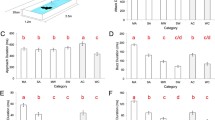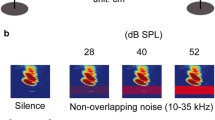Abstract
For a gleaning bat hunting prey from the ground, rustling sounds generated by prey movements are essential to invoke a hunting behaviour. The detection of prey-generated rustling sounds may depend heavily on the time structure of the prey-generated and the masking sounds due to their spectral similarity. Here, we systematically investigate the effect of the temporal structure on psychophysical rustling-sound detection in the gleaning bat, Megaderma lyra. A recorded rustling sound serves as the signal; the maskers are either Gaussian noise or broadband noise with various degrees of envelope fluctuations. Exploratory experiments indicate that the selective manipulation of the temporal structure of the rustling sound does not influence its detection in a Gaussian-noise masker. The results of the main experiment show, however, that the temporal structure of the masker has a strong and systematic effect on rustling-sound detection: When the width of irregularly spaced gaps in the masker exceeded about 0.3 ms, rustling-sound detection improved monotonically with increasing gap duration. Computer simulations of this experiment reveal that a combined detection strategy of spectral and temporal analysis underlies rustling-sound detection with fluctuating masking sounds.



Similar content being viewed by others
Abbreviations
- AFC:
-
alternative forced choice
- CMR:
-
comodulation masking release
- DSP:
-
digital signal processing
- NAP:
-
neural activation pattern
- M4:
-
waveform fourth moment
- O:
-
original sound
- PR:
-
phase-randomised sound
- RMS:
-
root mean square
- SNAP:
-
summary neural activation pattern
- SPL:
-
sound pressure level
References
Arlettaz R, Jones G, Racey PA (2001) Effect of acoustic clutter on prey detection by bats. Nature 414:742–745
Audet D (1991) Foraging behaviour of the indian false vampire bat, Megaderma lyra (Chiroptera: Megadermatidae). Biotropica 23:63–67
Buus S (1985) Release from masking caused by envelope fluctuations. J Acoust Soc Am 78:1958–1965
Dau T, Puschel D, Kohlrausch A (1996) A quantitative model of the "effective" signal processing in the auditory system. I. Model structure. Acoust Soc Am 99:3615–3622
Fuzessery ZM, Buttenhoff P, Andrews B, Kennedy JM (1993) Passive sound localization of prey by the pallid bat (Antrozous p. pallidus). J Comp Physiol A 171:767–777
Guppy A, Coles RB (1988) Acoustical and neural aspects of hearing in the Australian gleaning bats, Macroderma gigas and Nyctophilus gouldi. J Comp Physiol A 162:653–668
Hartmann WM, Pumplin J (1988) Noise power fluctuations and the masking of sine signals. J Acoust Soc Am 83:2277–2289
Heinze M, Schmidt S, Wiegrebe L (1996) Auditory temporal summation in the bat, Megaderma lyra. In: Elsner N, Schnitzler HU (eds) Proceedings of the 24th Göttingen Neurobiology Conference 1996. Thieme, Stuttgart, pp 235–235
Koller S (1969) Graphische Tafeln zur Beurteilung statistischer Zahlen. Steinkopff, Darmstadt
Krumbholz K, Schmidt S (1998) Classification of complex spectral patterns in the bat, Megaderma lyra. J Acoust Soc Am 105:898–911
Langemann U, Klump GM (2001) Signal detection in amplitude-modulated maskers. I. Behavioural auditory thresholds in a songbird. Eur J Neurosci 13:1025–1032
Marimuthu G, Neuweiler G (1987) The use of acoustical cues for prey detection by the Indian false vampire bat, Megaderma lyra. J Comp Physiol A 160:509–515
Meddis R (1986) Simulation of mechanical to neural transduction in the auditory receptor. J Acoust Soc Am 79:702–711
Meddis R, O'Mard L (1997) A unitary model of pitch perception. J Acoust Soc Am 102:1811–1820
Miller J (1996) The sampling distribution of d'. Percept Psychophys 58:65–72
Moore BCJ (1990) Co-modulation masking release: spectro-temporal pattern analysis in hearing. Br J Audiol 24:131–137
Moore BCJ (1997) Introduction to the psychology of hearing. Academic Press, San Diego
Nelken I, Rotman Y, Bar YO (1999) Responses of auditory-cortex neurons to structural features of natural sounds. Nature 397:154–157
Neuweiler G (1990) Auditory adaptations for prey capture in echolocating bats. Physiol Rev 70:615–641
Obrist MK, Fenton MB, Eger JL, Schlegel PA (1993) What ears do for bats: a comparative study of pinna sound pressure transformation in Chiroptera. J Exp Biol 180:119–152
Razak KA, Fuzessery ZM, Lohuis TD (1999) Single cortical neurons serve both echolocation and passive sound localization. J Neurophysiol 81:1438–1442
Schmidt S, Hanke S, Pillat J (2000) The role of echolocation in the hunting of terrestrial prey—new evidence for an underestimated strategy in the gleaning bat, Megaderma lyra. J Comp Physiol A 186:975–988
Schmidt S, Türke B, Vogler B (1983) Behavioural audiogram from the bat, Megaderma lyra. Myotis 21-22:62–66
Verhey JL, Dau T, Kollmeier B (1999) Within-channel cues in comodulation masking release (CMR): experiments and model predictions using a modulation-filterbank model. J Acoust Soc Am 106:2733–2745
Viemeister NF, Wakefield GH (1991) Temporal integration and multiple looks. J Acoust Soc Am 90:858–865
Weissenbacher P, Wiegrebe L, Kossl M (2002) The effect of preceding sonar emission on temporal integration in the bat, Megaderma lyra. J Comp Physiol A 188:147–155
Wiegrebe L, Krumbholz K (1999) Temporal resolution and temporal masking properties of transient stimuli: data and an auditory model. J Acoust Soc Am 105:2746–2756
Wiegrebe L, Schmidt S (1996) Temporal integration in the echolocating bat, Megaderma lyra. Hear Res 102:35–42
Wiegrebe L, Schmidt S (1997) Spectral integration in the echolocating bat Megaderma lyra and its relation to temporal integration of transient stimuli. In: Elsner N, Waessle H (ed) Proceedings of the 25th Goettingen Neurobiology Conference 1997. Thieme, Stuttgart; pp 358–358
Winter IM, Palmer AR (1995) Level dependence of cochlear nucleus onset unit responses and facilitation by second tones or broadband noise. J Neurophysiol 73:141–159
Zwicker E, Fastl H (1990) Psychoacoustics, facts and models. Springer, Berlin Heidelberg New York
Acknowledgements
We would like to thank Georg Klump for various fruitful discussions on rustling-sound detection and temporal effects of masking. We also thank two unknown reviewers for constructive reviews of an earlier version of this manuscript. This research was supported by a grant (Wi1518/6-1) from the Deutsche Forschungsgemeinschaft to L.W. The experiments in this study are non-invasive and do therefore not require an experimentation approval. Permission to keep and breed M. lyra in fulfillment of §11, Abs. 1, S. 1, No. 1 TierschG has been given to the Zoologisches Institut der Universität München by the Direktion des städtischen Veterinäramtes der Landeshauptstadt München, dated Nov. 6, 1992.
Author information
Authors and Affiliations
Corresponding author
Rights and permissions
About this article
Cite this article
Hübner, M., Wiegrebe, L. The effect of temporal structure on rustling-sound detection in the gleaning bat, Megaderma lyra . J Comp Physiol A 189, 337–346 (2003). https://doi.org/10.1007/s00359-003-0407-1
Received:
Revised:
Accepted:
Published:
Issue Date:
DOI: https://doi.org/10.1007/s00359-003-0407-1




